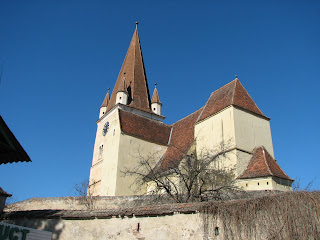The legend of the fortified church of Cisnădie tells us that a great treasure was once hidden inside. After numerous Ottoman attacks in the 15th century the village community built a secret chamber within the castle walls. Access was secured with a massive oak door, which could only be opened by pressing a hidden spring. From the outside, the entrance was camouflaged so well that only few insiders could find it. Not even the priests knew about it. Over the centuries, the knowledge of this hidden entrance got lost. At the beginning of the 20th century it was rediscovered and can be visited today.
In addition, not secretly hidden, but visible from far away visitors can spot the first clock tower in Transylvania, which is operated since 1425th, and the first lightning rod in Transylvania dating back to 1795.
 The bell ringer of Cisnădie provides expert guided tours of the castle and the church affiliated museum and has many more stories and legends to share.
The bell ringer of Cisnădie provides expert guided tours of the castle and the church affiliated museum and has many more stories and legends to share.





.JPG)


